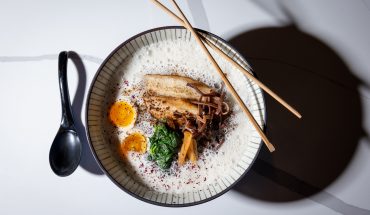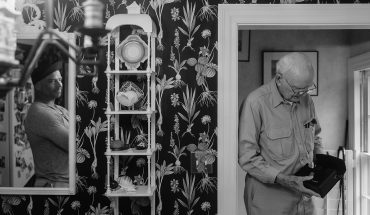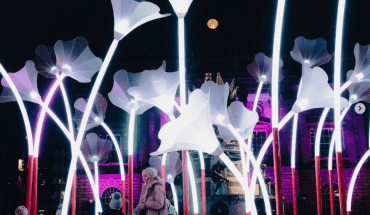
At the CAM exhibit, members of the U.N. Millenium Campaign: Jasmine Jaruphand, photographer William Moore, director Corinne Woods, and chief storyteller Saige Martin.
by Jessie Ammons
photograph by Nick Pironio
On a recent trip to Sri Lanka, Raleigh native William Moore wandered just a few streets over from the strip of five-star hotels where he was staying. “It was like entering this impoverished secret garden,” he recalls of the sudden shift to destitute surroundings. “Just past gem merchants and across a palm-lined avenue and you’re abruptly in another world.” It was there, though, that he found hope. “The people were poor, but happy and indefatigably welcoming,” he says. He snapped a photo of a boy playing cricket, a portrayal of determination and yet playfulness.
That image was flanked by three dozen others in Humans of MY World, a photo-narrative exhibition on display at CAM during December. A portion of the show will remain up through February.
Moore and his co-photographer, Saige Martin, both 24, traveled to 15 countries across five continents in the span of less than a year on behalf of the U.N.’s MY World Global Survey. The survey is a sort of humanized census: Any and everyone is asked to choose which issues matter most to them from a list of the U.N.’s sixteen millennium goals, from better job opportunities and healthcare to an honest and responsive government. While the poll is online, a team of U.N. employees has been taking to the streets of third-world countries to ensure no population is left out.
William and Saige were two of those team members. They decided to humanize the campaign even more. Inspired by a well-known photography project called Humans of New York by Brandon Stanton, the two picked up their cameras.
Stanton’s premise is to capture the essence of New York City via street portraits – William and Saige took an “explicit campaign focus,” William explains. “We concentrate on the personal experiences behind each person’s development priorities [from the U.N. survey]. What emerged was a really interesting conversation between photography, data, and storytelling.”
Indeed, the exhibition features poster-sized portraits alongside the photo subjects’ demographic data and quotes from their interview about what matters most to them. Some were heart wrenching, others lighthearted. (That Sri Lankan cricket player? He selected the survey’s choose-your-own option, to which he said, “cricket number one. Number two and three, also cricket.”) iPads at the exhibit allow viewers to take the MY World Global Survey and then view the most updated aggregate data, based on more than 7 million votes as of the printing of this story.
It’s a vivid and compelling display first curated for exhibit at the U.N. headquarters in New York, where William and Saige met and worked. It was so popular there that it’s since been shown at other venues and interpreted in a spoken word performance.
Bringing Humans of MY World to CAM was a homecoming for Moore. The exhibit’s launch coincided with his move back to Raleigh, a return he’s known he’d make since he graduated from Cary Academy. At a reception to celebrate the exhibit, dozens of his high school peers and childhood friends mingled with Martin and his U.N. colleagues, including the director of the U.N. Millenium Campaign, Corinne Woods.
A self-taught photographer, Moore holds degrees in American Studies and Foreign Policy and never imagined his work would one day hang on the walls of an art museum. This month, he’ll work with students at Exploris Middle School on social justice through photography project. It’s the people he met on his travels and the chance for them to be heard that keeps him going. “We made time everywhere we went to go out into the streets, go out into the villages, and really talk to people at length about their hopes, about their concerns, about their struggles,” he says. One photo depicts a somber elementary-aged boy in Buenos Aires. His quote says one of his biggest struggles is to “wake up in the morning with everything I had the night before.”
“There’s so much depth below that statement,” William says. “We’re all trying to hold onto what we have and, inevitably, we don’t always succeed.”



